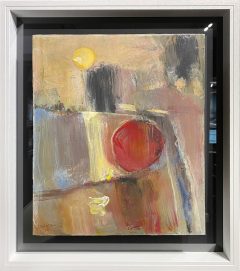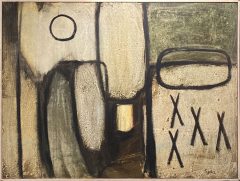Robert Sadler (1909 – 2001)
Showing all 2 results
Robert Sadler (1909 – 2001)
Robert Sadler (1909 – 2001) painted professionally from 1955 to 2001. After a career in the Royal Air Force and completing diplomatic and intelligence posts in Turkey. Denmark and the USA.
Sadler was born in Newmarket, England, the second son of racehorse trainer Harry Sadler and Ada Sadler. He showed great promise at drawing and painting as a child. Attending Eastbourne College and later Sidney Sussex College, Cambridge, where he read Mechanical Engineering. At Cambridge he joined the University Air Squadron and learned to fly. In 1930 he joined the Royal Air Force as a Pilot Officer.
In 1935 Robert was married to Madeleine Leach (neé Langley), widow of Felix Leach. They were together for 66 years.
Second World War
Shortly after the outbreak of the Second World War. Robert was posted to France as a staff officer with the Advanced Air Striking Force. The AASF suffered terribly under the overwhelming numerical superiority of the Luftwaffe. Robert returned to Britain with nothing but the uniform he stood up in.
Robert was next posted to command RAF bomber squadrons in England In 1942 he was transferred to the Air Ministry in London. Here he got his first chance to attend art school (Heatherly’s) and to develop his skills as an artist. In 1943 he was posted to Turkey, ostensibly as an instructor at the Turkish Air Staff College. but with the covert mission of helping to dissuade the Turks from entering the war.
With only a modest schedule of lectures to deliver. Robert was able to take his easel and water colours out into the Turkish countryside. He was also able to afford his own racehorse and a groom. A self portrait of him on Chammosaire survives.
England
Robert returned to England after the war as Station Commander at Binbrook in Lincolnshire. In 1947 he received a Diplomatic posting as Air Attaché to the British Embassy in Copenhagen. Where he continued to paint still lifes and landscapes in oils and to attend art school. He returned to Suffolk in 1949, living close to his brother Jack who was farming at Cheveley, where he painted more landscapes.
In 1950 Robert was posted to the RAF Officer Selection Board at Andover as vice-chairman. He rented a house near Stockbridge with his first real artist’s studio. And he began to devote more time to painting, taking his sketchbook, water colours and pastels out into the countryside, and turning other ideas into paintings in his studio. He attended Winchester School of Art and also did thumbnail sketches of the young men applying to be RAF officers, helping him to remember who was who.
RAF
Robert’s final RAF posting came in 1952 to the Pentagon in Washington DC. this was as part of an intelligence committee for the NATO Chiefs of Staff. He travelled extensively but was able to continue painting, including on one holiday with his family in Martha’s Vineyard; several watercolours survive from this trip. He also attended the Corcoran Gallery Art School in Washington DC.
On his return to England in 1954 Robert took early retirement from the RAF “to devote the rest of my life to painting”. He lived at first near Newmarket, to be close to his ailing mother. Most of his large and more exciting abstract expressionist paintings date from this period. Sadler was influenced by Jackson Pollock and Nicholas de Stael. He also returned to his love of painting horses, several times accompanying Sir Alfred Munnings to Newmarket Heath to do so. He joined the Cambridge Society of Painters and Sculptors and began to exhibit his work both in the UK and USA.
Studio
In 1963/4 Robert moved his family to Aldeburgh. He built a new studio in the garden of their home. In which he held a one-man show during the Aldeburgh Festival almost every year until 2001. He began painting mainly smaller landscapes (as if seen from a low flying aircraft), still lifes, figures and sometimes horses, but often turned to the abstract expressionism for which he is best known.
Robert also enjoyed yacht racing and golf. He earned honorary life membership of the Aldeburgh Golf Club by designing and constructing the nine-hole course.
He died in August 2001 and his ashes were scattered on the golf course that he designed.




